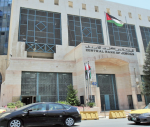AMMAN –– The number of motors vying for road space in Amman during peak hours is estimated at 1.8 million, Amman Mayor Aqel Biltaji said, saying the municipality has plans to decrease traffic congestion.
At a session hosted by Talal Abu-Ghazaleh Organisation on Monday evening, Biltaji said that Greater Amman Municipality (GAM) has started to improve its public transportation fleet as a solution to address traffic jams in the capital, attributing the fact that Jordanians prefer to drive their private cars due to the lack of proper transportation system.
He indicated that GAM has floated tenders to regulate parking on street sides, adding there are plans to establish venues for long-hour parking in buildings.
“The transportation issue is the biggest challenge of GAM,” he said, adding that it is unacceptable that there is no decent transport system in a city like Amman that is home to over two million people.
Biltaji mentioned that the average passenger rate per vehicle in Jordan is 1.3, while internationally it reaches 3.5 passengers per car.
The mayor told a large audience that the municipality has five main pillars to improve services to Amman residents, describing the objective as “doable, visible and affordable”.
Environment is the top priority, he said, adding that GAM will work on recovering the image of Amman as the outstandingly clean city it used to enjoy decades ago.
“Cleaning Amman from trash and giving Amman residents clean air will be our top priority,” he said, adding that removing eyesores such as street stalls is another objective.
As the municipality is planning to turn “trash into cash”, he said the landfill in Ghabawi is expected to increase its power generation from garbage from one to six megawatts in the near future.
Proving a decent transportation system is GAM’s second pillar, he said.
Proper planning for buildings and infrastructure is another objective for the municipality, according to Biltaji, who said that the current infrastructure cannot meet the rising needs of the increasing population.
Local development by empowering civil society organisations is also among GAM plans, he said.
Restoring Amman’s distinctive identity will be another objective, particularly the old and historical sites in the capital, he noted, adding the cultural identity of Amman “has been lost”.
Excess employment
Acknowledging the too-large number of employees at GAM, Biltaji said that he will be working on rehabilitating, “not restructuring”, the manpower at the municipality, highlighting that a decision has been taken to change the titles of 600 sanitation workers into “municipal monitors” who will be doing field work to detect violations related to buildings and traffic, among other aspects of the capital’s life under GAM’s oversight.
The assistants will be using personal digital devices to report violations directly to their headquarters.
The 600 workers are bachelor’s degree holders who have been hired at GAM under the title of sanitation labourers without practising the job, the mayor said as he acknowledged that GAM has been suffering from excess employment recruited through wasta.
















